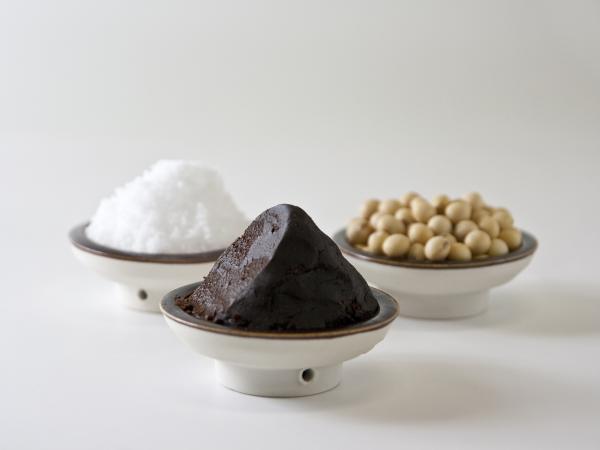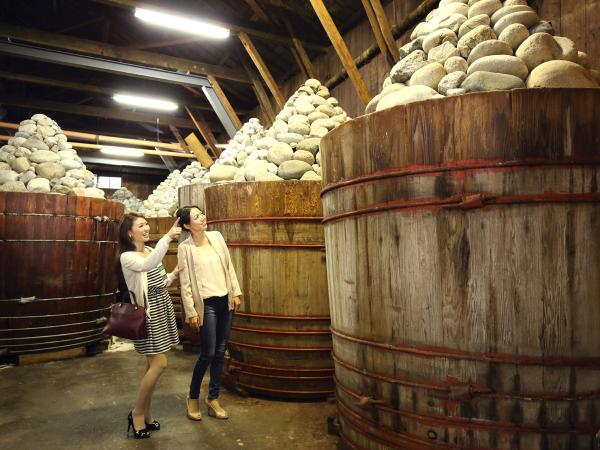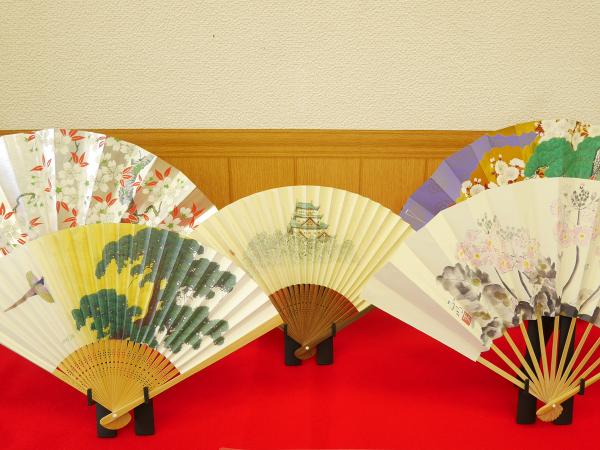Souvenirs are more than just random gifts for your friends, family, or for yourself. With the right souvenir, you can tell exciting stories of the destinations you visited, share your unique experiences there, and cherish the memories you made while your stay there. My personal favourites have always been souvenirs that can be used in my daily life back home, and not something just to put on the shelves and admire. I still remember the exciting reaction I received from an Italian friend when I brought her a pack of pre-cooked, microwavable Hitsumabushi set… The good thing about souvenirs from Aichi and Nagoya is that many of the specialities are actually perfect for everyday uses. Here are some suggestions for quality souvenirs from this region; little pieces of Aichi and Nagoya to spice up your life back home.
Uiro

It’s safe to say that “uiro” is one of the most iconic desserts of Nagoya. This chewy steamed cake made from rice flour has a long history of more than 350 years, and it comes in different flavours and pretty colours; green tea, brown sugar, azuki and sweet potatoes are just a few examples.
I personally love the pretty pink “sakura (cherry blossom)” flavour of the bite-size “Aoyagi Uirou Hitokuchi”, paired really well with strong green-tea. I get the strange impression that uiro has a unique position as a local “wagashi (Japanese sweets)”. It really is something more popular as a souvenir for travellers than to be consumed by the locals. Of course it doesn’t mean the locals don’t like it, in fact many are proud of it. As a souvenir from the host city of the famous Nagoya Women’s Marathon, I highly recommend uiro to athletes and hikers too. As an amateur hiker myself, uiro is a perfect backpacking food; it’s filling, easy to eat, and it keeps you going!

Miso

Fermented foods are back in fashion worldwide, and Aichi is all about fermented foods! Although miso is an essential ingredient for the food culture in any part of Japan, the people of Aichi have a particularly strong love and passion for their unique, nutritious, red, fermented soy-bean miso.
You really can’t talk about food in Aichi without talking about “Hatcho-miso”, which has its origin back in the Edo era. When I visited the old storehouse of Kakukyu, one of the two oldest Hatcho-miso manufacturers in Okazaki city, I was truly surprised to see the enormous wooden barrels and the heavy stones that were placed on top.

The manufacturing methods of Hatcho-miso remain mostly unchanged since its beginning, and the exceptionally long fermentation period is responsible for its deep, rich brown colour and salty-sweet flavour, which is very unique to this region. (The fermentation period of Hatcho-miso 2 to 2.5 years. They call it “two summers and two winters”, and it’s so worth the wait…)

It has such a significant taste that even the locals often mix it with other miso to make the taste a little milder (the mixture is called “awase miso”, and I personally grew up eating this “awase miso” at home). Unless you are used to using miso in your food, it might be a challenge to actually bring back a pack of raw miso as souvenir… So my recommendations are as follows:
1.Hatcho miso powder
Available from both Maruya and Kakukyu, this magical miso powder is great with anything; on salad, on steak, mixing it in the stew as a secret ingredient, or simply mixing it with mascarpone cheese (trust me!). One of the specialties of Kakukyu storehouse was soft-served vanilla ice cream topped with this Hatcho miso powder. Like many of you reading this now, I was suspicious of the taste before trying it… but in fact it was so delicious I immediately bought the little sachets in the shop, as a souvenir for myself. It’s easy to use and very unique, it will be a great introduction to the delicious taste of miso.
2.Kakukyu miso caramel
Salted caramels are also in fashion… so it goes without saying that miso and caramel are a perfect match. The saltiness and rich flavour of Hatcho-miso is balanced out by the sweetness of the caramel. The white sesame seeds blended in the caramel add extra flavour to it, and it really is an enjoyable candy… Perfect souvenir for adventurous children too, perhaps?
Moriguchi-zuke

It’s official: Moriguchi pickles are certified as the world’s longest pickled radishes, reaching up to 2 meters in length! Pickled in sake lees (leftovers from sake production), these radishes have a strong, mature taste and they go particularly well with a bowl of rice.
If you are a sake lover, they can also be a perfect nibble for drinks, and I personally love making omelettes with chopped Moriguchi-zuke inside…d-e-l-i-s-h! Here’s a confession though: I’ve never actually bought a full length of Moriguchi-zuke. Contrary to its unique and almost grotesque appearance (I say this with big love and respect), it is actually considered to be an expensive gift, so choosing this as souvenir will be a very noble gesture.
Aichi Sake

Aichi is blessed with the natural resources that are important for brewing delicious sake; good water, good soil for quality rice, and good climate. Today there are over 40 sake breweries, or “kura”, across Aichi, and a bottle of quality sake after a tour of the brewery will be a great souvenir for you to take home with.

Some Aichi sake brands, like Kamoshibito Kuheiji, are already world-renowned (their junmai daiginjo is listed on the menus of some of the Michelin 3-stars restaurants in Paris), while other names like Horaisen and Kintora are also loved by the locals and sake-fans in the country.

Local sake breweries also have a strong relationship with the local festival culture of Japan. As a big fan of the traditional “Hana-matsuri” festival in the Okumikawa region, the fresh, mild taste of Horaisen always brings back memories of the powerful energy of the masked-dances of Hana-matsuri.
The famous Toba No Himatsuri (Toba fire festival) in Nishio city is also a good one, accompanied by the local sake brand Sonnoh. The fruity aroma and the rich taste of their sake is very pleasant, and I never forget to bring a bottle home whenever I visit the festival. (I could dedicate a whole chapter on the charms of festivals in Aichi, so wait for future columns…) If you are a fan of traditional festivals, Aichi is a perfect destination for you, and you will easily find a good sake brewery near a good traditional festival!
Matcha
Nishio city in Aichi is one of the best production regions of tencha (tea leaves for matcha powder), providing high quality matcha characterised by its dark green colour, elegant aroma and mild flavour.

It has a strong relationship with how the tea culture flourished not only among feudal lords but also among tradesmen and artisans in this region, and today Nishio is sometimes referred to as “Little Kyoto”. A little tin of matcha will be a perfect souvenir for your daily use.

Traditionally, “Sado(茶道)”, i.e. the way of Japanese tea ceremony, has a series of strict rules and procedures that must be followed (sitting seiza-style for a long time is still my weakness…My legs get numb very quickly). However, there is no sin in enjoying matcha more casually.

Simply put a little spoonful of matcha in a bowl, add hot water and whip with a special tea whisk. There is something special about enjoying the bitter-sweet taste and the creamy texture matcha on your tea break, instead of your normal cup of tea. If drinking tea isn’t enough, there are many matcha related gifts available in both Nishio city and various souvenir shops around Nagoya.
A few of my favourites are the matcha-Baumkuchen and matcha buttercream sandwich cookies of Saijoen Aiya, but there are of course many different tea shops and patisseries that offer their original matcha sweets. Matcha works very well with the texture and sweetness of Western desserts, and I personally love enjoying these sweets with coffee too.
Pottery and porcelain

As mentioned above, Aichi has a long and rich history of tea culture. There is no doubt that this was also influenced by the fact that Aichi is home to two of the renowned “Six Ancient Kilns” of Japan; Tokoname and Seto. Both are still leading manufacturers of ceramics, and visiting these charming pottery towns to find the works of traditional (and contemporary) potters is a true joy.

Once a friend of mine from Seto city has jokingly told me; “we rarely buy cups and plates for ourselves… there’s always someone’s friend or someone’s uncle who is a potter and we get them for free…” True or not, it is a reminder that pottery really is still a big industry in this area.

If you are a Western tableware or teaware fan, or an admirer of Downton Abbey-esque lifestyle like myself, the beautiful cups and saucers of Noritake might be of particular interest. Founded in the early 20th century, Noritake is now one of the most treasured names in the ceramics and tableware industry.
I’m still very proud of my personal collection at home… A fine Noritake cutlery set passed down from my parents, and a pair of the famous blue Lacewood Gold cup & saucer as a wedding gift. The lifestyle shop “Noritake Square Nagoya” in Noritake garden offers a wonderful collection of tableware; from casual teacups to luxurious table settings. It really is a tableware paradise in my opinion… so prepare to spend a good few hours in the shop!
Shippo-Yaki

Cloisonne enamel works, known as “Shippo yaki” in Japan, are also one of Aichi’s most beautiful specialties. The exceptional manufacturing technique of “Owari-Shippo” was perfected in the mid-19th century, and Ama city and parts of Nagoya have since then become the centre of production.
Visit the Shippo Art Village in Ama and experience the techniques in the workshop where you can make your own brooches, key charms or pendants to take home.

At first glance, a work of Shippo yaki looks like a beautifully hand-painted porcelain (and for the longest time I mistakenly believed it was porcelain); it is fascinating to find out in the workshop that it actually is metalwork covered in kiln-fired enamel.
The rich and glossy colours of enamel are beautiful. You can also find a good souvenir for a special someone or even for yourself… They offer a variety of products, from flower vases, photo frames to accessories.
Arimatsu & Narumi Shibori

Arimatsu Shibori is a very Nagoya-specific, traditional handmade craft with a history of about 400 years. This particular tie-dyeing technique has many styles of patterns, and the dyed cloth (traditionally indigo-blue but available in many colours today) is then used to make kimono, yukata and other items.
Although Arimatsu shibori is often considered to be a part of the most traditional attractions Nagoya has to offer, there are also many young artists, designers and producers who have taken the techniques to create something entirely new.

One such example is the fashion brand Cucuri, and their adaptation of Arimatsu shibori into modern everyday clothes is quite fascinating, focusing on the “shaping shibori” rather than “dyeing shibori”. Another one of my favourites is Marimomen, a casual Arimatsu shibori brand by two young women, specialising in items that can be used in our daily lives, such as tenugui-towels and tabi-socks.
Like many other traditional industries, Arimatsu shibori also faces the lack of successors, but young artisans strive for a more creative future. Items of these new creators and others can be purchased in Arimatsu or in some bigger department stores in Nagoya.
Nagoya sensu (folding fan)
The history of Nagoya sensu dates back to the mid-18th century.

While Kyoto sensu are often used by women for cultural events like traditional dances and tea ceremonies, Nagoya sensu are more for formal occasions and are considered to be men’s fans. I once had the opportunity to participate in a sensu-making workshop held at Suehirodo, one of the oldest Nagoya sensu producers.
The procedure seemed pretty simple; participants were to draw freely on the paper fan and then glue it to the bamboo frame. How silly was I to think that it was going to be easy! Each step of sensu making requires a special technique, and Nagoya sensu truly are an aggregation of craftsmanship. If you have a chance, do participate in the sensu-making workshop, and then find a professionally and beautifully painted sensu in a sensu shop or quality department stores.

Writer
Irene Dewald
Irene is a radio DJ, TV presenter, narrator and MC from Aichi, Japan. She graduated from Royal Holloway, University of London in 2005, with a degree in drama and theatre studies. During her study abroad, she discovered her deep passion for traditional Japanese festivals and performing arts, which eventually lead her to return to Aichi and dedicate herself to promote local culture, traditions and hidden charms.


